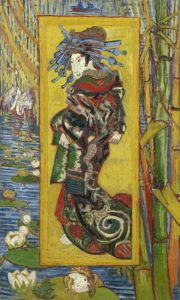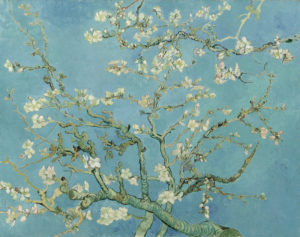As part of its fiftieth anniversary, the Van Gogh Museum in Amsterdam is teaming up with Pokémon to stage a new series of exhibits. This partnership will bring the creatures from the popular Japanese video game franchise into the vibrant world of the nineteenth-century Dutch painter. Not only is it a fun synthesis of the old and the new, but it also allows people to learn about Van Gogh’s relationship with Japan, particularly how he was influenced by Japanese art.
Vincent van Gogh openly spoke about his interest in and admiration for Japanese art. He first came into contact with Japanese ukiyo-e prints while in Paris. At the time, Japan was starting to open up after nearly two centuries of strict isolationism. Van Gogh fell in love with the colors, the form, and the aesthetics of Japanese ukiyo-e, acquiring several hundred of them and even exhibiting them in the cafés. Many European writers and artists credited Japan’s isolationism as preserving a pure society, untouched by modern problems like disease, overpopulation, and industrialization. Therefore, artists like Van Gogh looked to Japan and its art more or less as a form of escapism or even a panacea for Europe’s ails. Using his collection of ukiyo-e, Van Gogh created many copies and incorporated various elements into his own work. For example, in his 1887 Portrait of Père Tanguy, he shows the art dealer sitting in front of a background of various Japanese works showing landscapes, flowers, and depictions of geishas. These include a depiction of Mount Fuji rising above Tanguy’s head inspired by Utagawa Hiroshige’s Sagami River. Van Gogh even made his own copies of Hiroshige’s work, most notably using the printmaker’s Plum Orchard in Kameido as the basis for Japonaiserie: Flowering Plum Tree. Van Gogh also created his painting The Courtesan, modeled after a print by Keisai Eisen called A Courtesan, Nishiki-e.
The influence Japanese art had on Van Gogh’s work became even more apparent after the painter moved from Paris to Provence. Some artist historians and commentators even suggest that this move to southern France may have been because of his interest in Japan, specifically his desire to leave the urban metropolis behind him in favor of nature, farmland, and greater creative independence. In a letter to his brother Theo sent not long after relocating to Arles, Van Gogh wrote, “My dear brother, you know, I feel I’m in Japan”. While living and working in Arles and Saint-Rémy, Van Gogh Drew likely upon Japanese woodblock prints to create some of his most iconic works. Ukiyo-e‘s aesthetic began creeping into his paintings such as Almond Blossom. Such influence also appeared in his portraiture. In some of his works, like L’Arlésienne, Portrait of Joseph Roulin, and his many sunflower still-lifes, the subject appearing against a solid yellow-gold background seems inspired by Japanese screen painting. In letters to his brother Theo, Van Gogh mentions his appreciation for the Japanese artist Katsushika Hokusai. He specifically describes The Great Wave Off Kanagawa: “Hokusai makes you cry out the same thing – but in his case with his lines, his drawing, […] these waves are claws, the boat is caught in them, you can feel it.” Some have suggested that the dynamism of the great wave may have inspired the great swirling pattern in the sky and stars in his masterwork Starry Night.
Vincent van Gogh’s Japanese influences have previously been the focus of a Van Gogh Museum exhibition. However, this new collaboration with Pokémon seems less academic and more whimsical. The combination of Van Gogh’s work with Pokémon characters sees Snorlax and Munchlax passing the time in The Bedroom in Arles, Sunflora smiling among a sunflower still life, and Pikachu posing for a portrait in Van Gogh’s gray felt hat. Museum staff are also offering drawing lessons for younger visitors, teaching how to draw Pikachu.
However, not everything has been sunshine and rainbow cards. The museum was completely overwhelmed when the Pokémon exhibition first opened, but not everyone in the crowds was there to peruse the galleries. Many were there to go straight to the museum gift shop. Scalpers buying up the limited edition merchandise to sell out the back has become a serious problem for the museum and Pokémon. Both organizations issued statements, calling these visitors’ behavior “disappointing” and “regrettable”. Even the Pokémon online store got slammed, with Van Gogh merchandise selling out after a day or two. Some have criticized the museum and Pokémon’s lack of foresight regarding the merchandise’s popularity as a “disaster”.


